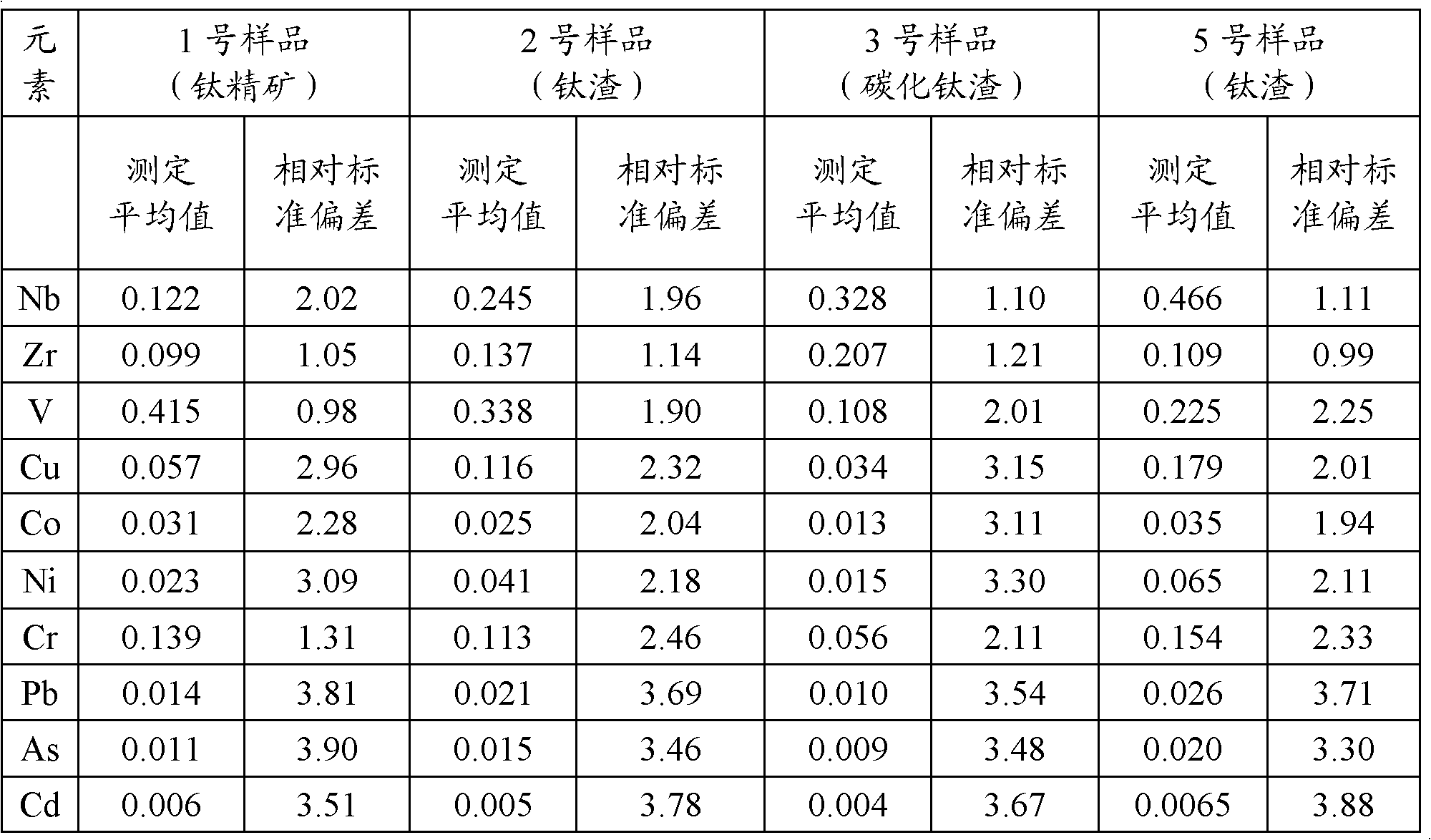Methods for digesting and detecting titanium concentrate, titanium slag or titanium carbide slag
A detection method, titanium carbide technology, applied in the direction of measuring device, test sample preparation, color/spectral characteristic measurement, etc., can solve problems such as inapplicability, and achieve the effect of improving product quality
- Summary
- Abstract
- Description
- Claims
- Application Information
AI Technical Summary
Problems solved by technology
Method used
Image
Examples
Embodiment 1
[0038] The hydrofluoric acid, hydrochloric acid, hydrogen peroxide and water used in this example are all of superior grade, the microwave digestion system used is Mars5 manufactured by CEM Company of the United States, and the ICP-AES instrument is the iCAP6300 inductor of Thermo Fisher Corporation of the United States Coupled plasma atomic emission spectrometer.
[0039] Digestion of titanium concentrate
[0040] In this embodiment, the sample to be tested is titanium concentrate (hereinafter referred to as sample No. 1).
[0041] Weigh 0.1000g of the titanium concentrate sample to be tested, first rinse the wall of the container with 3.0mL of water and shake the container to promote the suspension and dispersion of the sample; then, add 2.0mL of hydrofluoric acid with a mass percentage concentration of 40% to 47% The percentage concentration is 36%-38% hydrochloric acid, and the container is sealed. Use microwave heating method and set the conditions to raise the tempera...
Embodiment 2
[0046] In this embodiment, the sample to be tested is a titanium slag sample (produced by Panzhihua Iron and Steel Group) (hereinafter referred to as sample No. 2).
[0047]Weigh 0.5000g of the sample to be tested, rinse the wall of the vessel with 5.0mL of water and suspend and disperse the sample; add 5.0mL of hydrofluoric acid and 10.0mL, then set the microwave condition to 10min and raise the temperature to 150°C, and keep it warm for 8min for the first digestion reaction; After the reaction is over, cool the container at 95°C and slowly empty the gas in the closed container while it is hot. After opening the container, add 4.0mL hydrogen peroxide while it is hot. The microwave condition is set to 8min and the temperature is raised to 210°C, and the temperature is kept for 10min for the second digestion. reaction. In addition, the titanium slag sample was digested in the same manner as in Example 1 and detected with an ICP-AES instrument.
Embodiment 3
[0049] In this embodiment, the sample to be tested is a titanium carbide slag sample (produced by Panzhihua Iron and Steel Group) (hereinafter referred to as sample No. 3). In this example, the sample mass is 0.2500g, and the reagent dosages are: 3.5mL water, 3.5mL hydrofluoric acid, 6.0mL hydrochloric acid, 3.0mL hydrogen peroxide; the first microwave program is set to take 9min to raise the temperature to 130°C , keep warm for 6 minutes; the second microwave program is set to take 6 minutes to raise the temperature to 190°C, and keep warm for 8 minutes. In addition, the titanium carbide slag sample was digested in the same manner as in Example 1 and detected with an ICP-AES instrument.
PUM
 Login to View More
Login to View More Abstract
Description
Claims
Application Information
 Login to View More
Login to View More - R&D
- Intellectual Property
- Life Sciences
- Materials
- Tech Scout
- Unparalleled Data Quality
- Higher Quality Content
- 60% Fewer Hallucinations
Browse by: Latest US Patents, China's latest patents, Technical Efficacy Thesaurus, Application Domain, Technology Topic, Popular Technical Reports.
© 2025 PatSnap. All rights reserved.Legal|Privacy policy|Modern Slavery Act Transparency Statement|Sitemap|About US| Contact US: help@patsnap.com


